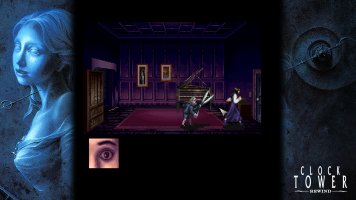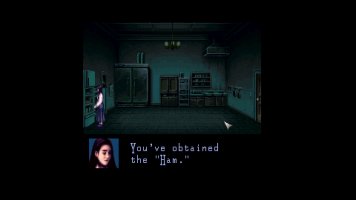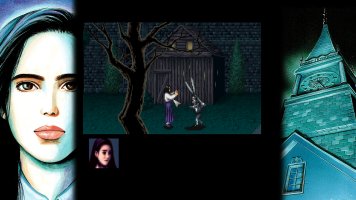Official Review
The Rewind edition introduces several significant improvements that enhance the original experience without compromising its core appeal. Players can now enjoy both the authentic classic mode and the enhanced Rewind mode, complete with save states, randomized enemy encounters, and the ability to reverse fatal mistakes. This review examines how these new features blend with the game's iconic mechanics and atmospheric presentation to create the definitive Clock Tower experience.
Gameplay and Mechanics
At its core, Clock Tower: Rewind delivers a unique blend of point-and-click adventure and survival horror gameplay that revolutionized the genre in 1995. The game employs an innovative control scheme where players guide protagonist Jennifer through the mansion using cursor-based navigation, while managing resources and evading the relentless Scissorman.
Point-and-click survival horror
The game's distinctive mechanics center around methodical exploration and item management. Players move Jennifer through the mansion by clicking destinations or using shoulder buttons, while investigating objects requires precise cursor control. This creates an intentionally measured pace that builds tension, especially during crucial moments when quick interactions could mean the difference between survival and death.Key gameplay elements include:
- Thorough environment investigation for vital items
- Strategic inventory management
- Randomized room layouts within specific mansion wings
- Multiple hiding spots to evade danger
Panic button and resting mechanics
The Panic System serves as both a health meter and survival mechanic. Jennifer's status is indicated by her portrait's color, ranging from blue (fine) to red (critical). When confronted by Scissorman, players can activate the Panic Button to resist attacks, but success depends heavily on Jennifer's remaining stamina.The stamina management adds another layer of strategy, as running depletes energy quickly. Players must find safe spots to rest, allowing Jennifer to recover her strength. This creates a delicate balance between exploration and conservation, as maintaining high stamina is crucial for surviving unexpected encounters.
Multiple endings and replay value
Clock Tower: Rewind features an impressive eight different endings, each determined by the player's choices and discoveries throughout the game. The branching narrative paths aren't simply determined by final decisions – they're influenced by the order of actions taken, items collected, and even which rooms are explored.The game's randomized elements enhance its replay value significantly. Each playthrough shuffles certain room locations and item placements, while Scissorman's appearances remain unpredictable. This randomization, combined with the multiple endings, ensures that no two playthroughs feel exactly alike, though careful planning is required as players can accidentally lock themselves out of specific endings through their actions.
The combination of these mechanics creates a tense atmosphere where every decision carries weight. Whether it's choosing to investigate a suspicious noise, deciding when to use limited resources, or determining the best moment to hide from the pursuing Scissorman, each action could lead players down a different path toward one of the game's many conclusions.
Graphics and Atmosphere
The visual presentation of Clock Tower: Rewind masterfully preserves the haunting esthetic that made the original a horror classic. Despite its 16-bit origins, the game's artistic direction proves that atmospheric horror doesn't require cutting-edge graphics to be effective.
Retro Super Famicom visuals
The pixel art in Clock Tower: Rewind showcases impressive attention to detail that holds up remarkably well in 2024. The detailed spritework brings characters to life through fluid animations, while the environments feature brilliant lighting effects that maximize the capabilities of the 16-bit style. Jennifer's character animations are particularly noteworthy, conveying genuine fear and exhaustion through subtle pixel movements.The visual storytelling employs a "show, don't tell" approach that makes excellent use of the limited graphical capabilities. This is particularly evident in the cave sequence, which delivers one of the most striking moments in horror gaming through clever use of sprite scaling and shadow effects.
Atmospheric mansion setting
The Barrows mansion stands as a masterclass in horror game environment design. Each room features distinct architectural details and careful lighting that creates unique atmospheric spaces. The environment design includes:- Dramatic shadows that create tension in corridors
- Intricate period-appropriate furniture and decorations
- Dynamic lighting effects during chase sequences
- Environmental storytelling through carefully placed details
New animated cutscene
Clock Tower: Rewind introduces a gorgeous animated opening cutscene that enhances the narrative without compromising the game's classic feel. This new addition provides context for Jennifer's arrival at the mansion while maintaining the original's foreboding atmosphere. The animation quality matches the game's pixel art style while adding modern flourishes that bridge the gap between old and new.The visual presentation extends beyond mere esthetics, creating a psychological impact that modern horror games still strive to achieve. The unnerving silence broken by sudden musical cues, the careful use of darkness and light, and the detailed sprite animations all work in concert to create an atmosphere of constant dread. This approach to horror visualization has influenced countless games in the genre, from Silent Hill to Resident Evil, proving that Clock Tower's visual design was truly ahead of its time.
New Features in the Rewind Edition
The Rewind edition brings substantial improvements to this classic horror game while maintaining its core identity. These enhancements modernize the experience for both newcomers and veterans alike, making the game more accessible without sacrificing its challenging nature.
Original and Rewind game modes
Players can choose between two distinct experiences: the Original mode, which preserves the authentic 1995 Super Famicom version, and the enhanced Rewind mode, which introduces numerous refinements. The Original mode remains untouched except for essential modern features like mouse support and save states.The Rewind mode offers significant improvements:
- Restored content including a previously deleted room and scenes
- Enhanced character animations and faster movement
- Improved stair navigation for Jennifer
- Accelerated stamina recovery during rest periods
- Refined enemy AI and movement patterns
Randomized Scissorman encounters
One of the most significant additions in the Rewind mode is the complete overhaul of Scissorman's behavior. The iconic antagonist now appears at truly random intervals during exploration, creating unprecedented tension. This unpredictability stands in stark contrast to the original's more predictable encounter patterns.The enhanced Scissorman AI demonstrates more intelligent pursuit behaviors, including the ability to properly navigate between rooms and climb stairs instead of relying on teleportation. This improvement makes encounters feel more organic and threatening, as the stalker's movements follow logical patterns that players can anticipate and counter.
Save states and rewind feature
The new save state system serves as the primary method for recording progress, replacing the original's autosave functionality. While this change might seem controversial to purists, it offers greater flexibility in managing difficult sequences and experimenting with different choices.The titular rewind feature, while limited in scope, provides a safety net for critical moments. Players can reverse approximately 15-20 seconds of gameplay, though its utility is somewhat restricted by the game's deliberately slow pace. This feature proves most valuable during specific decision points rather than during general exploration or chase sequences.
These modern additions complement the game's existing mechanics without undermining its horror elements. The randomized encounters and improved AI create a more dynamic and unpredictable experience, while the save states and rewind feature help mitigate some of the original's more punishing aspects. The balance between preservation and enhancement makes this version particularly noteworthy for both newcomers and returning players.
Verdict: A Classic Reborn
Evaluating Clock Tower: Rewind presents an interesting challenge: weighing its historical significance against modern gaming standards. This remastered version of the influential horror classic delivers a mixed but fascinating experience that deserves careful consideration.
Pros and cons
The strengths and limitations of Clock Tower: Rewind reflect both its pioneering heritage and the constraints of its era:Strengths:
- Masterfully crafted atmosphere that remains effective
- Iconic soundtrack that enhances tension
- Multiple endings providing substantial replay value
- Valuable historical preservation
- Quality of life improvements like quick saves
- Rich bonus content including developer interviews
Who this game is for
Clock Tower: Rewind caters to specific audiences, each likely to experience the game differently:| Player Type | Appeal Factor | Experience Level |
|---|---|---|
| Horror Enthusiasts | Atmospheric tension and historical significance | Moderate to High |
| Retro Gamers | Authentic preservation of classic gameplay | High |
| Point-and-Click Fans | Puzzle-solving and exploration elements | Moderate |
| Modern Gamers | May find mechanics challenging | Low to Moderate |
The game particularly resonates with players who appreciate methodical pacing and can overlook dated design elements in favor of atmospheric storytelling. Those seeking modern horror conventions might find the experience less accessible, though the new quality-of-life features help bridge this gap.
Final recommendation
Clock Tower: Rewind succeeds as both a historical preservation and a legitimate horror experience, though with important caveats. At $19.99, the price point requires careful consideration. For horror genre enthusiasts and those interested in gaming history, the package offers substantial value through its combination of the core game, bonus features, and new accessibility options.The remastered version strikes a delicate balance between preservation and modernization. While the added features like save states and the rewind mechanic make the experience more approachable, they don't fundamentally alter the game's challenging nature. The inclusion of developer interviews, motion comics, and other supplementary content adds meaningful context to this influential title.
The verdict ultimately depends on player expectations:
- For those seeking to experience a pivotal moment in horror gaming history, Clock Tower: Rewind delivers an authentic and enhanced version of the original
- Players primarily interested in modern horror experiences should approach with an understanding of the game's historical context
- Point-and-click adventure enthusiasts will find a unique blend of genres that, despite its age, still offers compelling gameplay
Conclusion
Clock Tower: Rewind stands as a masterful example of how classic horror games can remain relevant through thoughtful modernization. The careful preservation of the original's atmospheric tension, combined with smart quality-of-life improvements, creates an experience that honors its legacy while welcoming new players. These refinements, from save states to randomized encounters, enhance rather than diminish the game's fundamental horror elements, proving that genuine fear transcends technological limitations.
The lasting influence of Clock Tower extends far beyond its technical achievements, cementing its place as a cornerstone of horror gaming history. Modern developers continue drawing inspiration from its innovative approach to psychological horror and pursuit-based gameplay. Whether experienced as a historical artifact or a genuine horror adventure, Clock Tower: Rewind delivers an atmospheric journey that demonstrates why this pioneering title deserves its legendary status among horror games.






